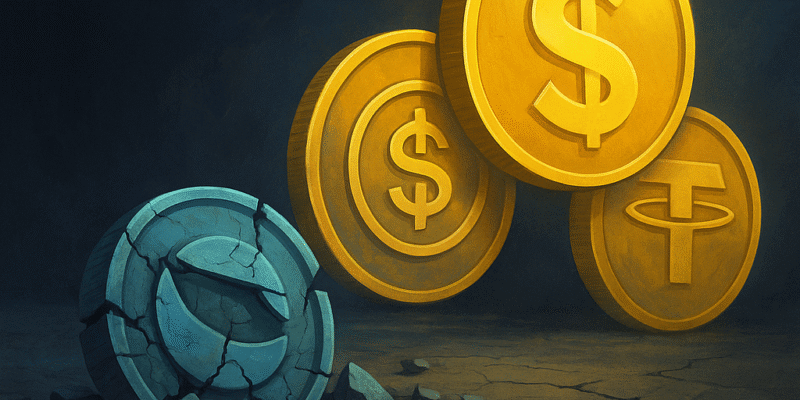The collapse of TerraUSD (UST) in May 2022 stands as one of the most significant stablecoin failures to date. At its peak, UST had a market capitalization of about $18 billion, making it one of the largest stablecoins in circulation. Within days, its value fell close to zero, wiping out billions of dollars in investor funds and shaking trust in the entire market.
UST’s design relied on an algorithm and its sister token, Luna, to maintain its peg to the U.S. dollar. When more than $2 billion worth of UST was suddenly unstaked and sold, selling pressure triggered a loss of confidence. Luna was printed in massive quantities to defend the peg, but instead of restoring stability, this led to hyperinflation of Luna’s supply. Both tokens collapsed together, leaving holders with coins that were nearly worthless.
The fallout was global. Retail investors lost savings, particularly in South Korea and the United States, while institutions were forced to reassess exposure to algorithmic designs. Regulators responded quickly. The U.S. Treasury and the SEC cited TerraUSD as a case study in stablecoin risk, and South Korean authorities pursued criminal charges against Terra’s founder, Do Kwon, for fraud and securities violations.
What the TerraUSD crash revealed is simple: stablecoins without strong collateral are vulnerable. Unlike USDT (Tether) and USDC (Circle), which hold reserves in assets such as cash, treasuries, and bonds, UST had no equivalent backing. Its peg depended entirely on market confidence, and once that confidence broke, there was no safety net.
In the aftermath, stablecoin projects have shifted strategies. USDC strengthened its reporting standards, publishing monthly attestations from Deloitte to show reserves. Tether also expanded its disclosures, although questions about its transparency remain. New entrants like Ripple’s RLUSD and Justin Sun’s sUSDD are highlighting audits, collateral ratios, and Peg Stability Modules to reassure users that stability is grounded in real assets and clear mechanisms.
The lesson from these stablecoin failures is that transparency and collateral matter far more than branding or promises. Algorithmic designs may seem innovative, but they struggle when stress-tested in volatile markets. Stablecoins backed by verifiable reserves stand a better chance of surviving shocks, and users are becoming more selective in where they place their trust.
The TerraUSD collapse left deep scars, but it also forced the market to evolve. By raising expectations for audits, disclosures, and reserve quality, it may ultimately pave the way for safer digital money. For users and regulators alike, the event remains a reminder that stability in finance is built on trust, and trust depends on facts.

Comments